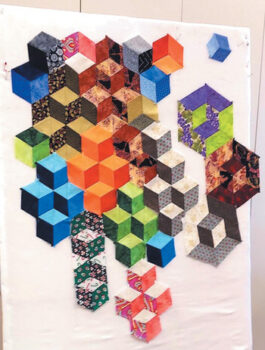
Cubes arranged to create tumbling block effect
Jonnie Chandler
Quilting is more than simply cutting fabric and sewing pieces of material together. In practice, quilting requires attention to accuracy and design as well as a process of color choices and inspiration. Traditionally, quilting is considered as sewing fabric together to create bedding.
The quilting procedure is completed by joining three layers of fabric to create a quilted blanket. The layers are the quilt top, batting, and backing. The quilt top is created by sewing pieces of fabric together following a pattern or a design technique. The batting, usually cotton, polyester, or wool, is sandwiched between the quilt top and the backing. The three layers are quilted or sewn together by hand on a domestic sewing machine or the longarm. A quilting longarm is a special sewing machine placed on a frame that is anywhere from 17 to 21 feet in length that is designed for big quilting projects.
Quilters are challenged by new techniques and design. They strive to develop their skills with patterns, tools, rulers, or templates, to create unique patterns using colors and/or prints.
Kathleen O’Connell is an icon in the quilters’ guild. She has challenged well-established and novice quilters to hone their skills and develop new talents. Each year Kathleen challenges PebbleCreek Quilters (PCQ) members to a new project. This year’s project, the tumbling block or multiple cubes, teaches a new technique of design and skill. The tumbling block technique attempts to achieve a high contrast design that manages to give a quilt a sensational and spectacular effect. The technique involves a three-dimensional aspect using geometric prints or colors from light to medium to dark.
Kathleen and Cathy Howell guided 17 determined quilters in a workshop to teach the tumbling block design. The tumbling block is less a pattern, it is more a technique that involves laying out fabric to create a cube or tumbling block design.
The traditional way to piece a tumbling block quilt is with diamond shapes and Y-seams that creates a hexagon shape. Quilters usually avoid Y-seams as it is difficult to create the hexagon shape by machine. Y-seams are easier to piece by hand, but this method is time consuming. Therefore, geometry definitely becomes the quilter’s friend with the use of a 60-degree ruler or rhombus. The 60-degree diamonds are cut into two 60-degree equilateral triangles, thereby creating a tumbling block quilt with chain piecing, without the Y-seams.
Even though this method is simpler, it is still difficult. The process was at times frustrating, but the quilters remained determined to achieve the desired cube effect. PCQ members love a challenge and will meet this one by completing the 2023 Tumbling Block Challenge Quilt.
The 2023 Tumbling Block Challenge Quilts will be on display in the Creative Arts Center in early spring.
